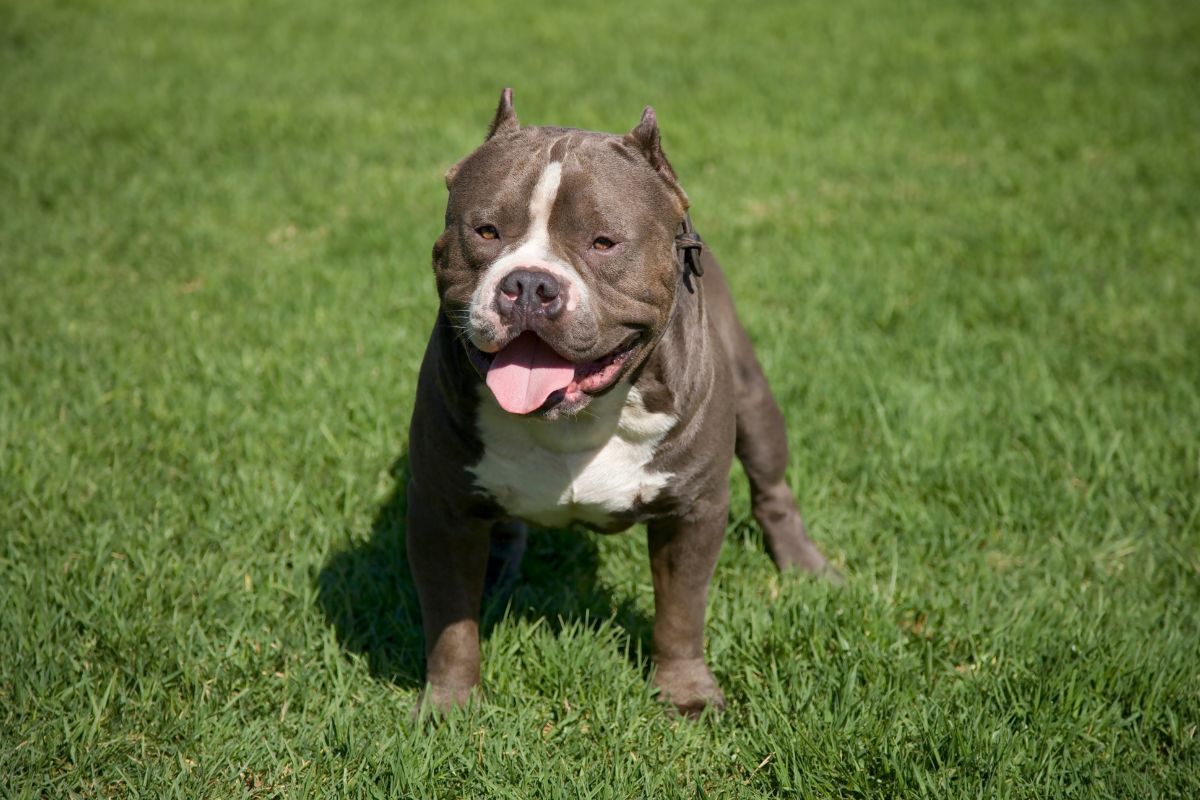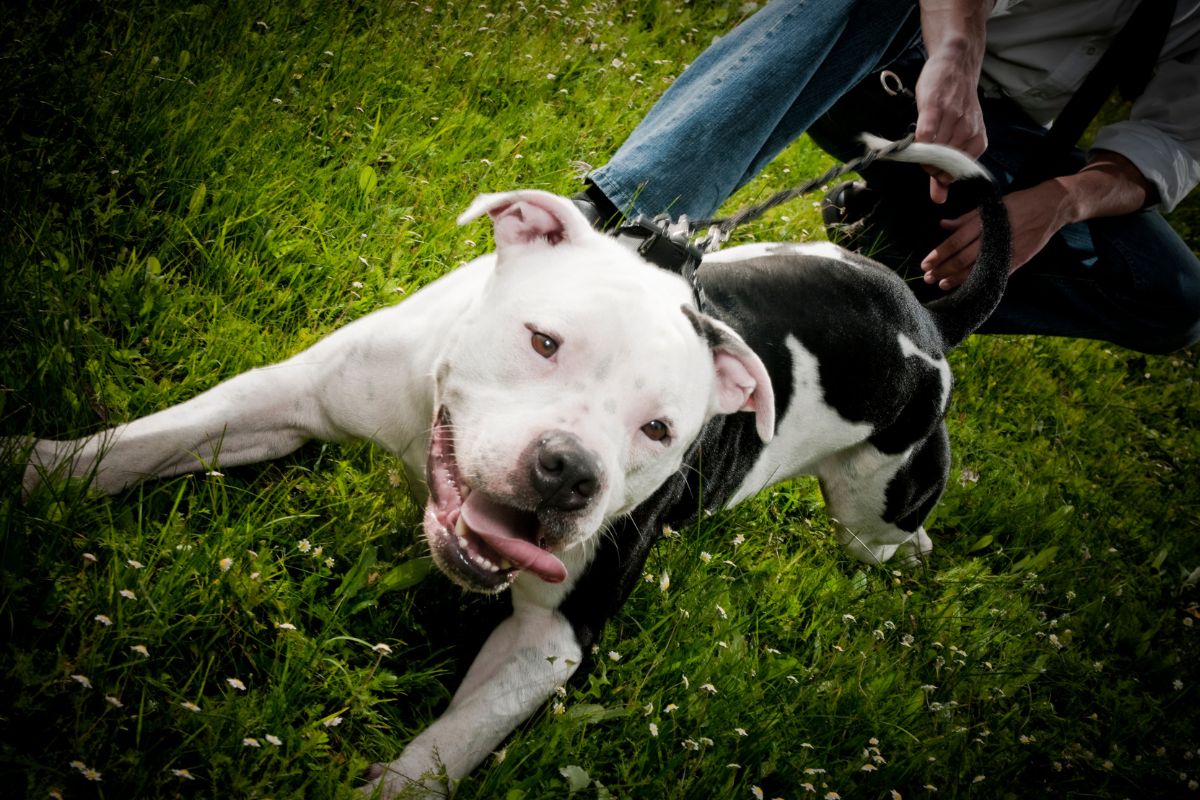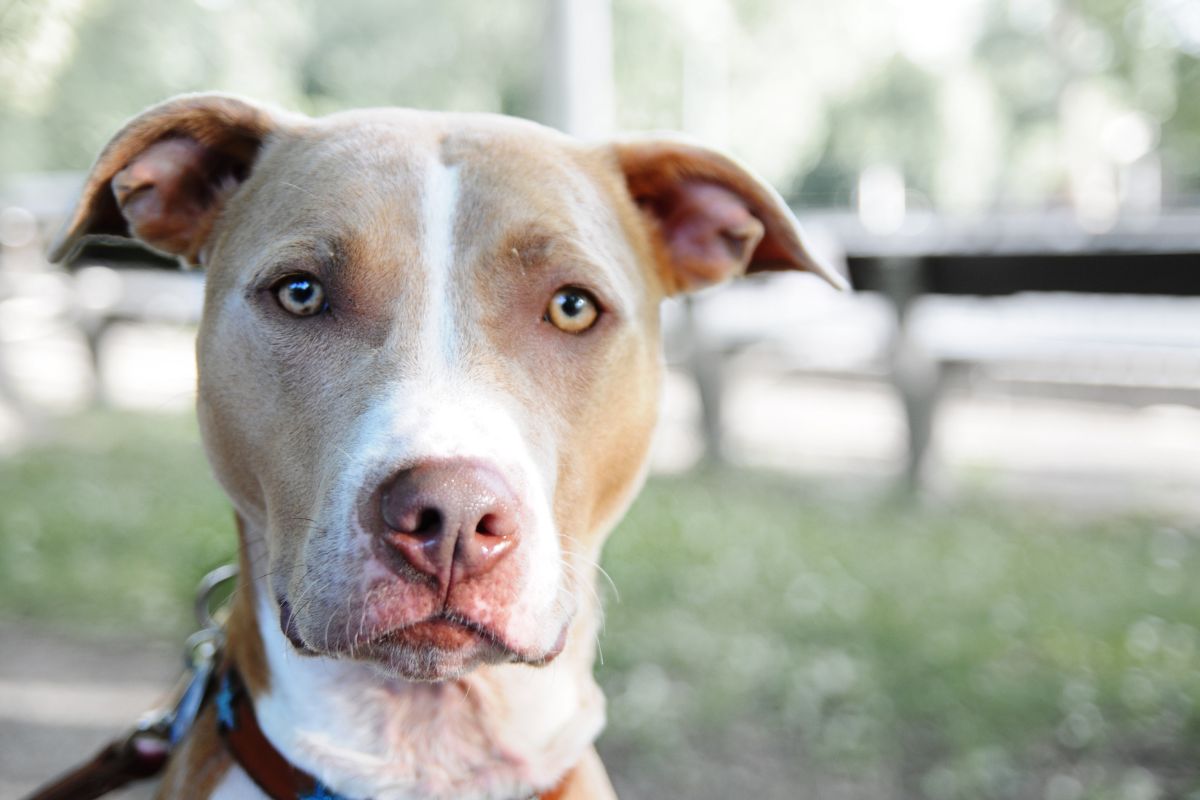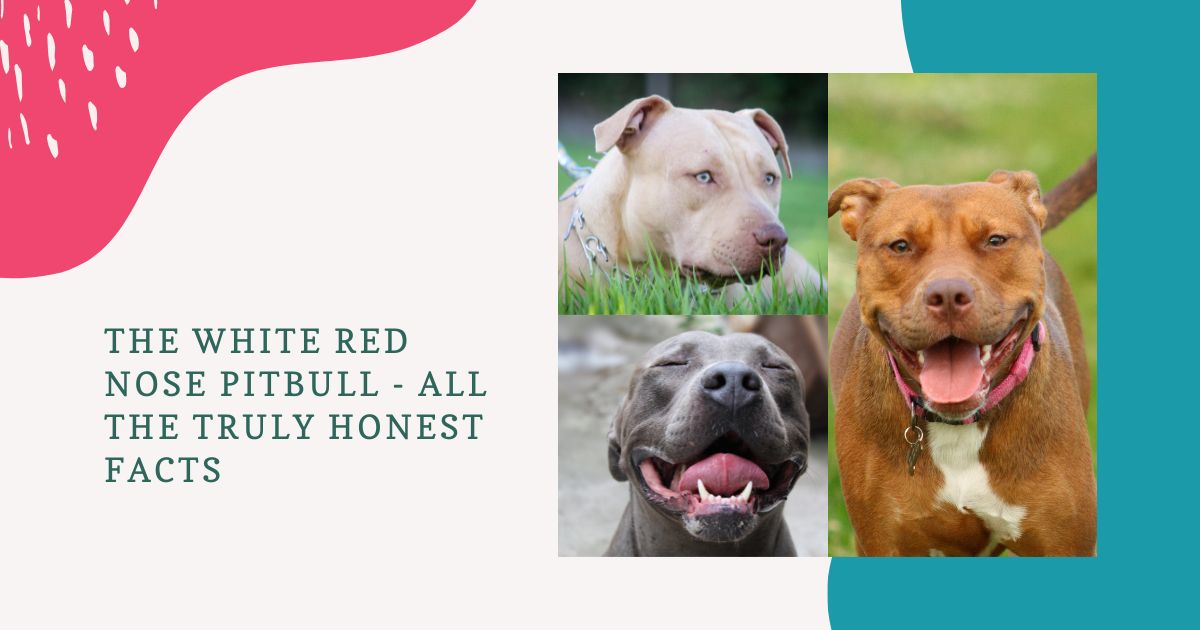Red Nose Pitbulls are becoming a more and more popular choice for a pet. And having a White Red Nose Pitbull seems like a literal jackpot for some.
Loyal and friendly, these dogs are nothing but a bundle of joy if one knows how to take care of them. Unfortunately, the unjust reputation that still follows them makes the final decision difficult.
This is why in this article, one will find all the answers to the most troubling issues when having a Red Nose Pitbull.

The White Red Nose Pitbull
Red Nose Pitbull dogs are extremely unique. They belong to the family of the American Staffordshire Terrier and are very intelligent and active dogs.
Red Nose Pitbulls have various coat colors, with white being the rarest. Due to their energetic yet friendly and gentle demeanor, these dogs are perfect as hunters and companions.
However, White Red Nose Pitbull puppies need constant training. One has to remember it when bringing them to the family.
How Much Do Red Nose Pitbulls Cost?
When one thinks about bringing a Red Nose Pitbull home, the first thing one must worry about is the price.
Like many bred dogs, Red Nose Pitbull is an expensive breed to ask for. Before going there and looking for a dog, the first step is to do primary research. Tragically, many unscrupulous breeders manipulate prices. And this is not the main issue.
There are many cases of cruel breeders or even owners (in the case of backyard breeding). Make sure you’re working with a person with extensive knowledge of the dogs they breed and experience.
Good research will help you understand whether you are ready to take a Pitbull. Unfortunately, many dogs of this breed end up in shelters because their former owners did not prepare themselves properly.
For a start, one can ask family or friends if the idea of buying a Red Nose Pitbull came from them or if someone is a specialist. Other places to inquire are breed clubs or training clubs. The primary focuses on a specific breed, so if any breed clubs work with Red Nose Pitbulls, it makes sense to check them.
Finally, one can talk to the local veterinarian and ask them about the place to buy a dog and the nuances of care and training.
When the research is complete, the price is next. Several aspects shape it, from the coat color to how much money the breeder has put into health tests.
Red Nose Pitbull is a rare breed within the APTB family, so the prices will be high. For example, the Red Nose Brindle Pitbull can cost around $500 and up. One shall also consider adopting the dog as the adoption fees are slightly cheaper (around $350 to $600), but the exchange is much more humane.
Despite coming from the same family, brown and white Pitbull dogs cost differently. To compare, the price for White Red Nose Pitbull puppies ranges from around $1,000 up to $3,000.
Dog’s gender also matters. Female dogs fetch a higher price usually in case of potential breeding in the future. If one decides to have a White Red Nose Pitbull female dog, it makes sense to clarify the price beforehand.
Still, we recommend adopting Red Nose Pitbull dogs instead of buying from a breeder. One must remember it’s a living creature, so giving an abandoned dog a second chance is nothing but priceless.
The History of the Red Nose Pitbull
The Red Nose Pitbull’s history starts around 4,000 BC. According to sources, the Greeks used Mastiffs一the long-time ancestors of Pitbulls一as working dogs in peaceful times and as fighting dogs during wars.
The closer origin of these dogs can be in Ireland, where the long line of Old Family Red Nose strain of Pitbulls comes from. This line, in turn, originates in the middle of the 19th century as Old Family Dogs. Later, they got the name Irish Old Family Reds before eventually becoming the Old Family Red Nose strain.
This same line was the reason for the recognizable red coloring of Red Nose Pitbulls.
As wealthy people in the United Kingdom loved dogfighting, they often crossed Bulldogs and Terriers as they both had impressive strength and could fight viciously. Eventually, these two breeds became the Pitbulls’ ancestors.
Interesting fact: the name “Pitbull” comes from the games these dogs participated in, specifically ratting and bullfighting; the game usually occurred in the pit, hence the name.
However, as the authorities banned the dog fights later, another idea appeared to sail dogs to the U.S. to continue the good sport. The crossing became even more active on the wider lands of America.
In the later years, breeders crossed the most powerful dogs to make even larger ones for fights. Today, people know the result of these attempts as the American Pitbull Terrier.
Their job was to look after cattle. Unfortunately, the association with a dirty dog fighting business and bullfighting discredited Pitbulls, devaluing them as pets.
Luckily, they slowly started regaining pet status a couple of decades ago. Red Nose Pitbulls are beloved family members and even therapy dogs in hospitals or retirement homes. They also have another name一nanny dogs一for their friendly interactions with children.
The Color Genetics of the White Pitbull Explained
White Red Nose Pitbull puppies are not expensive for no reason. Although not impossible to find, they are still pretty rare. And the reason why is the genetics behind the coloring.
Genetics is complicated, so for breeders who eventually “break the code,” the price for their services is proportional to the efforts.
A simple biological fact一we need two parents to make a baby. Both mother and father share half of their genetic code with their offspring. But this is where it gets a little more brain-challenging.
Like the future puppy, its parents bear the halves of genetic codes from their parents, and so forth. And those who had an A+ in the school course biology must remember there are two types of genes一dominant and recessive genes. The primary always prevails over the latter.
To breed an all-White Red Nose Pitbull, the breeder must calculate the proportion of parental gene codes and the incidence of each dominant gene.
All Pitbulls inherit their colors (e.g., white and brown Pitbull, the most popular and the most rare, respectively) depending on the paint’s gene value. For example, the black coat is dominant, while red is recessive.
It means that even if one of the parents has a black coat, their child can inherit it. However, both parents must have red as their recessive gene for a red-coated puppy. Basically, like two minuses give a plus in math.
The base coat pigments for any breed are black (eumelanin) and red (pheomelanin). Their combination on the gene level determines the coat color.
However, white spots can occur when the skin cells cannot produce any of those pigments. Not only that, but the dog’s skin and paws turn pink as there is no pigment.
The DNA consists of chromosomes. In turn, the latter can either move or stay fixed. The genes responsible for the white coat in dogs stick to the same place in the chromosome一the S (Spotting) locus. Locus is a fixed position on a chromosome with a specific genetic marker.
There are two alleles (a variant form of a gene) that sit in the S (Spotting) locus: S (produces no or little white) and Sp (creates areas or full white).
To make a white Red Nose Pitbull, these alleles (especially Sp) should be recessive in both parents. Then, there is a chance the baby may be completely white. However, the most likely cases are Red Nose Pitbull white with brown spots or black/brindle/brown with white spots.
Still, one must remember that all dogs deserve love and care, regardless of the color of their coats. Genes aren’t everything.

Leucism vs. Albinism -The Difference
There is one nuance, however. You may look at two White Red Nose Pitbull puppies and not find a difference. But there is a difference, and this is the case between albinism and leucism.
While a White pitbull can result from scrupulous breeding, there are two other occasions when Red Nose Pitbulls turn out white.
The first is albinism一an extremely rare genetic mutation one can notice in animals, humans, and even plants. The condition implies a total lack of pigmentation in the skin, hair, eyes, and blood vessels. For a Pitbull puppy to be an Albino, it must inherit two mutated genes from both parents. If that happens, the dog’s body becomes unable to produce melanin.
Albino Pitbulls are very sensitive creatures, susceptible to various medical issues like skin cancer. The owner has to be extra careful to notice any sores or bumps on the dog’s skin due to its fragile immune system.
Upon good research, one may be able to differentiate an albino Pitbull. They have unusually small eyes and deformities around their parts like the lens, iris, sclera, etc. This is why these dogs may suffer from poor vision or even be blind. If one sees a White Red Nose Pitbull with blue eyes一it is most likely an albino. A pink nose Pitbull is also albino in 100% of cases.
Like other dogs, albinos deserve all the love in the world. But besides the sentiment, one must be genuinely ready to take care of them and realize the financial costs and moral responsibility of taking an albino Pitbull.
As for leucistic Pitbulls, they fall between true Whites and albinos. Unlike the latter, leucistic dogs have partial loss of pigmentation. They also have deeper blue eyes, which differentiates them from albino Pitbulls. However, genetic testing is the best way to make things clear.
Also, leucistic Pitbulls have fewer health problems than albinos, thanks to their genetic makeup.
Now that one can distinguish White Pitbulls, albinos, and leucistic Pitbulls, the selection process will be easier.
Their Appearance and Temperament
Red Nose Pitbulls have quite a unique appearance from the numerous crossings the breed went through.
To start with the color, one already knows about the beautiful black, brown, red, and copper fur. At times, they can have drops of white or cream on them. Not only that but their lips and paws also differ depending on the fur color.
Another striking detail of Red Nose Pitbulls’ appearance is their eyes. Usually, they have an intense amber color. But as we mentioned earlier, albino and leucistic Pitbulls have blue and deep blue eyes, respectively.
As a rule of thumb, all the features of Red Nose Pitbulls’ appearances are visible from birth.
What one could also notice is the phenomenal musculature of these dogs. A full-grown White Pitbull has a stocky and athletic build, so they look larger than average Pitbulls. This peculiarity also comes from the history of breeding, when they were most popular as fighting dogs.
The muscular look also spreads to the dog’s head. That’s why Red Nose Pitbulls have distinct chiseled heads with broad jaws. Their muscular neck also sticks in one’s memory. Depending on the owners’ decision, some Pitbulls can have cropped ears, which is unnecessary.
The White Red Nose Pitbull looks the same as the rest of the dogs of this breed. Nevertheless, some distinct features include black or dark brown colors of the nose and lips. Brown or blue eyes are typical for White Pitbulls.
Those who spent at least some time with Red Nose Pitbulls know they are very sweet and not aggressive. Usually, they are up to anything, whether it’s a walk or a lazy coach-laying session. Thanks to their adaptability, these dogs are perfect family members.
Remembering their fighting past, Red Nose Pitbulls are easy to train. However, because they are so friendly, they usually make bad guard dogs, so one should not consider them as being lazy.
If the dog had enough exposure to other dogs as a puppy, it would be really sociable. But if not, they may have difficulty trusting new dogs, to the point of fear or aggression. Red Nose Pitbulls are also suspicious of rodents or small animals because of their ratting experience.
Overall these dogs are incredibly sweet and empathic, so one should not worry about them not getting used to the family.
Bully Exercise and Training Requirements
As we mentioned, Red Nose Pitbulls are very able to train. Not only are they strong for physical exercise, but they are also intelligent, which makes working with them really pleasant.
The first thing the owner (or trainer) has to establish is dominance. Using a commanding voice and maintaining eye contact is a good way to do so. This way, both the person and the dog know their positions in the relationship, which will help avoid misunderstandings in the future.
Next thing every dog needs when training is encouragement. The Pitbull deserves a good treat and praise when it does the right command or shows proper behavior. These little gifts and actions of affirmation will show the pittie that it did a good job, meaning it will likely repeat the same behavior next time.
Still, even if the dog does mess up a little or does not understand the command, saying no to them or not showing affection will make the dog sad and discouraged.
Remembering how affectionate Red Nose Pitbulls are, they need love from their family to feel stable. This is why talking and celebrating a dog’s smallest achievements are necessary. The positive association will motivate the Pitbull to try again instead of being anxious to fail.
However, if a misunderstanding occurs during training, the modern force-free training method can be effective. Here, the dog learns to focus on the desired behavior rather than fixing the habits the owner doesn’t like.
When the dog makes a correct command, the owner has to give them a reward immediately, like treats, praise, or a favorite toy. This way, a pittie will build positive associations and do better work next time.
Lifespan and Associated Health Concerns With Pitbulls
The Red Nose Pitbulls are very healthy dogs in general. The critical exception is Albino Pitbulls, which are predisposed to diseases because of the lack of pigmentation. But other than that, the color or other external features do not affect the lifespan of these dogs.
The average age for Red Nose Pitbulls is 12 to 16 years, which is a long life for dogs.
Still, despite being pretty healthy dogs, one should consider a couple of health concerns. First is hip dysplasia and knee problems.
Genetics and environmental factors are the main reasons for the predisposition to hip dysplasia. Usually, it is the back legs that suffer. Because of genetic inheritance after decades of breeding, hip dysplasia comes from Staffordshire Terriers. In this case, the hip forms improperly, causing pain and increasing the risk of arthritis.
Luckily, the condition is not critical, and many treatments ensure the dog leads a happy life.
As for the second issue, we tackled it a bit. Skin conditions are not rare for Red Nose Pitbulls, specifically the White ones. It is important to differentiate between White and Albino Pitbulls, as the latter have an increased predisposition to skin conditions. This means UV rays are a big trigger warning for Pitbulls owners.
A good solution would be applying sunscreen on the areas of skin with less hair, such as the muzzle or ears. Keeping the dog out of the sun also works.
Some Red Nose Pitbulls can also suffer from heart diseases and allergies, but they are case-to-case. To prevent heart issues, maintaining a healthy weight is important. Regular vet visits and attention to the dog will help notice all health issues.
If one notices their dog bumping into things or stumbling, a check-up for eye problems may be a good idea. In old age, all dogs have a risk of developing cataracts or other eye diseases.
Another important thing is vaccination. The vets recommend three puppy shots of the (DHLPP) + Corona vaccine for Pitbulls under 16 weeks to prevent health problems. During 7 to 9 months, the puppy should undergo a Heartworm test.
Finally, after 4 months, the vet should administer the first rabies shot. All the necessary vaccinations must repeat annually to ensure the dog’s good health.
Nutritional and Grooming Needs
The feeding norm for Red Nose Pitbulls depends on the pet’s size, age, and activity level. One should keep in mind the calorie intake increases as the dog grows. Consulting with a trustworthy vet can help make healthy nutrition for the Red Nose Pitbull.
Other than that, Red Nose Pitbulls are really unpretentious regarding food. These dogs are up to homemade food the same way as dry or wet dog food.
One thing to consider with Red Nose puppies (6 months and lower): it is best to feed them 4 to 6 meals a day in small amounts. Soft food is perfect for puppies as they have trouble chewing. But three meals a day are enough if the puppy reaches over six months.
For adult Red Nose Pitbulls, protein intake is the priority. One must make sure their dog’s diet includes about 35 to 40% of high protein, 15 to 20% of fats, and fewer grains. Meat and fish oils are excellent sources of nutrients.
Another thing to consider is calcium. Because Red Nose Pitbulls are prone to hip dysplasia and arthritis, they need a regular calcium intake. Puppies also need it for better growth.
Maintaining weight is critical for this breed, so feeding must be responsible and not over-indulgent. The perfect calorie intake is 1,300 to 1,600 calories a day.
Because Red Nose Pitbulls have short and smooth coats, they need low to moderate grooming. Brushing with a bristle brush is perfect for them. Bathing is stress-free with these dogs; one must only buy a good shampoo (liquid or dry) for dogs so that the pet’s coat is shiny and silky.
When brushing teeth (once a day), using a small toothbrush is most convenient. And as for ears and eyes, soft pieces of cotton will help. Remembering Red Nose Pitbulls are active, cutting their toenails is necessary so they don’t damage the furniture or hurt themselves or family members. The only note is not to cut them too short to avoid pain.
Other Breed Characteristics
One must remember other things before bringing a Red Nose Pitbull home.
First, shedding. Red Nose Pitbulls shade twice a year, specifically in the shedding season. Usually, there’s not much trouble, as they shed moderately. It may take a bit of cleaning, but not critical.
Red Nose Pitbulls are not hypoallergenic. Because they are short-coated, they collect fewer allergens and are safe for people with allergies.
If there are children in the house, Red Nose Pitbulls have no trouble with them. As we‘ve mentioned, this breed is very friendly and loves playing. They can bark at times, but only if there is a new person or they are confused.
However, one must remember not to leave their Red Nose Pitbull alone for more than 3 to 4 hours, as they are prone to separation anxiety. This can spill out into destructive behavior. If one tends to leave longer, it is better to consider crate training. Treats and toys can be helpful.
The Size of a Full-Grown White Red Nose Pitbull
Red Nose Pitbulls are medium-sized compared with other breeds. In terms of size, Red Nose Pitbulls range from medium to large and reach around 17 to 21 inches (43 to 53 cm) in height. For male dogs, the normal size is 18 to 21 inches (46 to 53 cm), and for females一17 to 20 inches (43 to 51 cm).
They are also pretty heavy, weighing 50 to 65 lbs (22 to 29 kg) as an adult. For males, the optimal weight ranges from 35 to 60 lb (16 to 27 kg), while for females, it is 30 to 50 lb (14 to 23 kg). Maintaining a healthy diet and activity will help control weight.
Are Red Nose Pitbulls Dangerous?
In general, Red Nose Pitbulls are friendly and amiable. They are never aggressive towards people they love, like family members.
However, their reactions may change if they enter a new environment or meet a new person or another dog they did not see before. Not necessarily aggressive, but Red Nose Pitbulls can become cautious of the “intruder.”
Suspicious behavior shows the dog’s protective side as they guard their family’s safety. Even socializing with other people and dogs from a young age does not fully fix this habit.
Red Nose Pitbulls rarely attack unless there is a trigger or provocation. If in danger, they also become more guarded. But other than that, they are not aggressive.
However, one must remember that it is painful if Red Nose Pitbulls bite. They have a strong jaw and a fighting past, so triggering them will not be a good idea.
Luckily, proper training, reaffirming talks, and active socialization can ease the temper of Red Nose Pitbulls. As for the rest, there is nothing to worry about. These dogs are incredible family members and beloved pets.
In Which Countries/States are Pitbulls Illegal to Own?
Some countries have banned Pitbulls, either fully or partly. The main reason is reputational, as people still associate aggression and fights when it comes to Pitbulls.
Among the countries that banned Pitbulls at home and from entering are the Netherlands, France, Germany, Puerto Rico, Italy, Denmark, and Venezuela.
Some other countries have partial bans. For example, Singapore allows having Pitbulls at home but bans the country entry. Poland has adopted several laws regarding fencing and reinforcements for Pitbulls. New Zealand and Australia have a ban on Pitbull’s entering. Some regions of Austria, Belgium, Brazil, China, Canada, and Japan also have restrictions.
The Pros and Cons of This Breed
To wrap up, here are the main pros and cons of having a Red Nose Pitbull in your family.
To start with, Red Nose Pitbulls have more advantages, which makes the final decision much easier. The most distinct features are high intellect, which makes the training pleasant and fast.
The second advantage is loyalty. As we have mentioned, Red Nose Pitbulls are incredibly friendly and loving regarding family. They are also very protective, which only adds to their loyalty.
Red Nose Pitbulls are also adaptable, meaning they can live in houses and apartments. On top of that, they have a good balance of activity and calmness. They love walking outside but don’t mind watching TV with their family.
Finally, these dogs are pretty outgoing and confident, so if there is an urgent business, one can take a dog with them without worrying.
On the other hand, Red Nose Pitbulls can have difficulty connecting with strangers or other dogs, but training usually helps manage it.
The second disadvantage is the dog’s high prey drive. Remembering their past, it is no wonder these dogs may feel too energetic. But other than that, there are not many reasons not to have these incredible dogs as family.

The End
In conclusion, having a Red Nose Pitbull home is a good idea. Their unconditional loyalty and love are worth all the effort to raise them. Easy to take care of and train, Red Nose Pitbulls differ entirely from their unjust reputation.
Still, it is essential to know their history to understand these dogs. Doing good research and finding a trustworthy breeder will test one’s readiness to have a dog. One must also be ready to take care of an albino pitbull if this is their choice.
One way or another, deciding to have a beautiful Red Nose Pitbull as a family member is always right, so let the fear stand aside.

